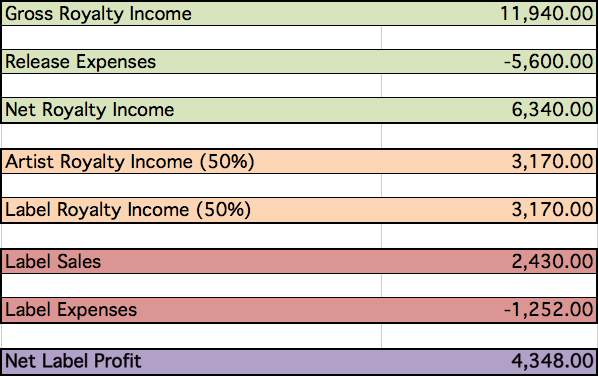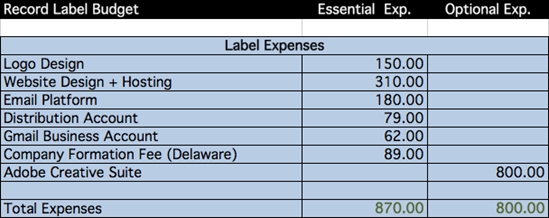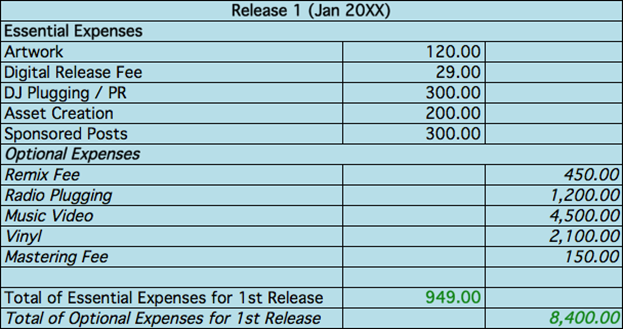In this lesson I’m going to show you 'How to Do a 12 Month Budget for a Record Label and Music Releases'. I explain record label accounting basics and how you how to calculate your label profits.
If you are looking to start a record label, how much is going to cost?
To figure out how much you need to invest you going to have to get an understanding of the different types of expenses, and which ones are startup costs, and which ones are label expenses and which ones are release expenses.
So What Are Label Expenses and Release Expenses?
Label expenses are the bare essentials to set up and run your record label. These are non-recoupable expenses, and are paid out of the labels share of the profits.
What is the difference between recoupable are non-recoupable expenses?
A recoupable expense is an expense that is directly related to the cost of releasing a song E.G. artwork, PR, remix fees. This is what we call a Release Expenses.
A non-recoupable expense is an expense not directly related to the release of a song(s). E.G. Company formation fee, office rent, website hosting, employee wages etc. This is what we call Label Expenses.
To get a better understanding, let's do a recap on some label accounting basics.
When you sign a song from an artist, you both agree to a Royalty Income split (declared in the contract) which, for independent labels is typically a Net Profit deal of 50/50.
Before you deduct recoupable expenses this Royalty Income is called Gross Royalty Income, and AFTER recoupable expenses deductions it is called Net Royalty Income
Gross Royalty Income – Release Expenses = Net Royalty Income
You then split the Net Royalty Income 50/50 between the Artist and Label. For Example
$100 Net Royalty Income = $50 Artist Royalty Income + $50 Label Royalty Income
You send the artist the Artist Royalty Income and the Label Royalty Income is the labels share.
To get your label profit you add any other sales income, for example merchandise income and then deduct your non-recoupable Label Expenses.
Label Royalty Income + Other Label Sales - Label Expenses = Net Label Profit
Here is an example as illustrated by a small indie record labels Profit and Loss summary.

Label Expenses
Let's breakdown the some of the common label expenses for your first year of operation.

Logo Design
This price varies depending on what you choose in 'Designing the Logo' section. For the purpose of the budget we will use the budget amount for a freelance designer of $150.
Website Design + Hosting
Like the logo design this will depend on what you decide to use in the 'Choosing a Website' section; for the purpose of the budget we will use the budget amount for the annual fee of $310 for a 'website in a box' option.
Email Platform
This is the annual fee for a professional email provider to manage your email subscribers. We have chosen to use the Send in Blue platform which has a $180 annual fee.
Distribution Account
This is the annual fee for setting up a label account with Distrokid, which will be the quickest way to set up your labels distribution. If you get distribution with a platform that works on percentages, this can be omitted.
Gmail Business Account
I would recommend using Google business account for your business, as it gives you access to the suite of business applications for document and spreadsheet processing as well as the ability for Gmail to host your business email address securely.
Company Formation Fee
This is the service fee for to incorporate your record label as an official business. This will depend on which country and state you are based, and I have used the fee expense for forming a company in the Delaware state of the US.
Adobe Creative Suite
Today more than ever you need to be able to edit pictures on the fly and quickly format them for the various social media sizes and purposes. I would suggest getting an Adobe CC package as it includes all of the essential tools to edit pictures, logos, and videos easily. There is a ton of tutorials on YouTube as well for learning about most of the functions you would use Photoshop for.
You might use a design platform such as Affinity, which would be one of cost of $70
This is an optional expense however so we have placed it in the optional costs section.
Other Business Expenses
Other non-recoupable business expenses worth considering are office space rental, travel, employee wages, and business rates.
These are not included in the budget template as these will differ greatly depending on what city and country you are based in and if you are starting out, often will not be an expense you need to worry about until you are a more established record label. Also, with the impact of COVID-19, many labels have chosen to have completely office free companies, having all staff work from home.
If you do intend to have these expenses from day one then insert them under the Label Expenses tab.
Most of these expenses are one off. If you are already set up – you’ll only be looking at the reoccurring expenses.
So for planning for the next 12 months – the next most important expenses are your release expenses.
Once you know what the average expense is for each release you do on your label, and you know how many releases you will do in the next 12 months, you can then calculate your 12 month budget.
12 month label operating expenses + average release expenses x No. of releases you do in 12 months = total budget for 12 months
Release Expenses
Release expenses are directly related to the cost of releasing a single, EP or album. For the sake of this example we have kept it to the most common essential and optional expenses, but it is no means exhaustive. If you have any other expenses, insert a new line into your budget and add to the expenses.

Artwork
Artwork is the second most important creative asset you have after the music. And if there is one place to spend more money it's here. I won’t go into to much detail as we will cover more of this in the marketing and PR chapters.
In the interests of being budget conscientious, I’ve put in a budget of $120 as this is the approximate price when using a service such as www.designcrowd.com which we have used in the past.
As you will more than likely be doing a series of releases then a great way to get a good price is to negotiate a bundle deal. Agree to five pieces for $100 each, which is a healthy $500 contract for the design artist and gives you enough artwork for the foreseeable future as well as having nice continuity across your branding.
Digital Release Fee
If you are using a using a self-distribution model, which will be likely if you are starting out, then most platforms will charge some upload fee, or fee to have the music available on all platforms for eternity.
If you have completed the 'Choosing a Distributor' section, then enter the cost of the digital release fee here. For the purpose of the template I'm going to use the Distrokid ‘Leave a legacy’ fee as we have chosen them as the distributor in the label expenses sections.
DJ Plugging/PR
This is another expense that can vary quite a bit depending on your approach and the type of music you are releasing.
If you choose to do your own PR in-house, by which I mean you or a member of your team will do the PR, then your cost will be lower than using an hiring a PR agency, but there is still an expense if you use a database service like SubmitHub.
If you're releasing hip hop or electronic music to be played in the clubs for DJ's you need to get your music out to the DJ's that are playing in the clubs. The easiest way to do this is to go to a specialist company that have a trusted list of top DJ's that subscribe to the database and they will send your music to the DJ's and collect feedback on the music which you get to see in a report.
It is worth noting that the promo company will review your music and if they don't think its up to par or relevant to their database, they won't be able work with you. Prices for this start at around $250-$500 for a DJ mail out campaign.
If this is your first release on the label, we want to hire a independent PR agency to help plug the music to radio and specialist taste makers. For our budget example if put this at $300.
Digital Asset Creation
This expense refers to the cost of creating marketing assets such as a teaser trailer, lyric video, or promo interview. There are tools available for creating these yourself, but for the budget example the expense is $200 for creating a lyric video from a freelancer on a website such as Fiverr.com.
Sponsored Posts and Paid Advertising
These days, even if you have 100,000 fans on your Facebook artist page, unless you run sponsored posts or ads you only reach a fraction of your fans organically.
You'll definitely want to promote your music releases here so make sure you have included budget for this.
This is also why it’s placed under the essential costs column. For this example we will use $300 to create Facebook and Instagram sponsored posts and paid advertising.
Optional Release Expenses
These are expenses that will vary depending on each single, EP or album you release. The general rule of thumb is that the bigger the track and artist, the more you are going to spend here.
If the track has a pop commercial edge and the artist is a rising star, you may want to get a established radio plugger onboard to promote to radio stations. Or if you have a track that's been picked up by a big YouTube channel, you may want to make a music video to help drive views.
Remix Fees
If you plan on having remix tracks on a release then you'll need to add this to the budget. If you are an electronic record label, once you are more established you can have fellow label artists remix each other as favours so this might not always need to be factored in as an expense.
But if you want producers beyond your contact list then you'll have to pay a remix fee. Fees will be anything from $400 for new rising talent, to $5000 for an established well known producer.
Radio / Spotify Plugging
I have included these together as I’m seeing more and more song pluggers doing both radio and Spotify plugging as Spotify plays become increasingly as important (if not more for so for indie artists) as getting radio plays.
Music Video
If you can budget for a music video for your first release then do it. It's a great way of making a statement straight out of the gate and an excellent asset for PR and marketing team to work with. Plus it gives you a load of extra content to use around the release, such as behind-the-scene pictures, and interviews with director and artists.
As a ballpark figure to get a decent professional music video (without needing to pull any professional favours) is around $4000.
Vinyl Costs
If you want to press vinyl to create something special, you will need to work with a disc manufacturing company. It's best to pick a company based in or close to your home country to keep shipping costs to a minimum. The more vinyl you buy, the cheaper it gets, but you have to weigh that up against how many you expect to sell.
For example, using the www.discmanufacturingservices.com pricing table, you are looking at $1500 for 250 vinyl records, or $2100 for 500 vinyl records. For the purpose of the budget I've listed a 500 vinyl pressing run.
Recording, Mixing and Mastering Expenses
As we are focusing on the business side of running a indie record label we have not included music production costs such as studio recording costs or mixing engineer expenses.
These days a lot of indie music is produced in home studios or smaller studios where the artists have often done the mixing, mastering and production costs themselves. This is also true for electronic music, and almost all electronic artists mix and master their own tracks.
If the recording agreement with your artist does include covering the recording, mixing and mastering costs as part of the release then you will need to insert extra lines in the releases section of expenses as these are costs that are recoupable from music royalties.
For this example, as we are getting vinyl pressed, we will say we have the release mastered by a professional engineer to get both a vinyl and digital master of the track for $150.
NOTE: If you're already engaged in the music industry, or in your local music scene I highly recommend that when starting a label you use all the contacts at your disposal and pull in favours where possible to keep costs down. Somewhere along the line you'll be able to return the favour in kind.
The investment you need to set up your labels first release and the label infrastructure is your biggest investment, as when revenue starts coming back into the label, you then have this to reinvest into your operational costs.
You can also choose to invest money as you need it for each release. A lot of artist-based labels have funded their label this way, using money from other sources of income such as live shows, merchandise, or even a day job to fund each release.
Conclusion
To recap - total budget for 12 months equals the label operating expenses for 12 months + the number of releases you intend to do in the next 12 months x the average cost of releases.
And that was the formula for 'How to Do a 12 Month Budget for a Record Label and Music Releases'!
Available in all major podcasting platforms.
DOWNLOAD THE RECORD LABEL STRUCTURE TEMPLATE